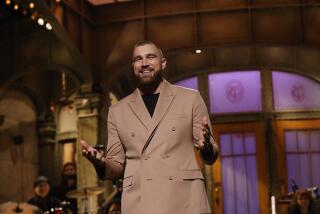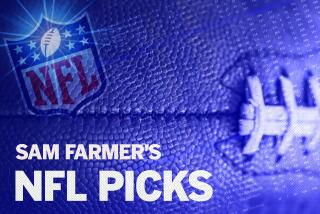Pro Football / Bob Oates : On Balance, Jets Can Handle Dolphins
- Share via
When the Miami Dolphins lost in the Super Bowl last winter, they were exposed as a one-dimensional passing club needing more running and more defense to complement quarterback Dan Marino.
Monday night, it seemed clear that they haven’t improved enough. Although they can still beat most teams with Marino, they’re in trouble against better-balanced teams.
Thus, the New York Jets, who have two threats--runner Freeman McNeil and passer Ken O’Brien--to Miami’s one, rolled to an easy 23-7 victory.
Without worrying about any Dolphin runner, the Jets used all their defensive resources to rush Marino and surround his receivers.
The Jets, the last AFC team to adopt the 3-4 defense, lost to the Raiders on opening day, 31-0.
“We weren’t ready for the Raiders,” defensive Coach Bud Carson said Monday night.
They appear to be ready for anything now.
Sid Gillman, the Hall of Famer who will be 74 on Oct. 26, is back in football as the quarterback coach of the Philadelphia Eagles.
It’s probably no coincidence that the Eagle quarterback, Ron Jaworski, has the club moving again. He has thrown six touchdown passes since Gillman joined the Eagles last week at New Orleans.
Last month, Jaworski had been so ineffective that Philadelphia replaced him with a rookie, Randall Cunningham.
Gillman first coached Jaworski during the Dick Vermeil years at Philadelphia, 1976-82, then spent a season with the L.A. Express, but was out of the game last year.
What does an old football coach do when he’s out of a job?
In Gillman’s case, he subscribed to every cable company that shows football. He also bought two VCRs to tape every game he didn’t see live, and some that he did. And he kept his film projector warm, persuading NFL friends to send him more than 50 movies of 1984-85 pro games.
Gillman bet his life, in other words, that someday, somebody would still want a 74-year-old passing specialist. When the Eagles called, he was ready.
Many old football players look forward to retirement. Gillman isn’t one of them.
“This is really living,” he said the other day from his Philadelphia office. “On the biggest day I had (in retirement) last year, I went to the post office twice. I also got a haircut that day, as I recall. And I played nine holes of golf. That isn’t living.”
The NFL’s Hilgenbergs, brothers from Iowa, were both in California last week. Jay was in San Francisco with the Chicago Bears, Joel in Los Angeles with the New Orleans Saints.
Both are centers--the league’s only brothers who are starters at that position.
Or as Joel told New Orleans writers: “We’re the only family I know of that plays catch not facing each other.”
When the New York Giants lost a close one to Cincinnati Sunday, 35-30, their coach, Bill Parcells, said: “I’m kind of embarrassed. Nobody got anything done today. Nobody. I mean nobody.”
Included in this indictment, apparently was his quarterback, Phil Simms, who had just passed for 513 yards--the second-most in NFL history.
Cincinnati Coach Sam Wyche seemed to have a better handle on what happened.
“Stats never win ballgames,” Wyche said. “The two things that win ballgames are big plays and turnovers.”
Comparing America’s major team sports, Raider owner Al Davis said: “The worst thing about football--the only bad thing--is the injuries.”
Unlike athletes in baseball and basketball--and most other sports--football players spend every week face to face with the prospect of season-ending--often career-ending--injuries.
That prompts a question: How often do NFL defensive linemen deliberately try to get the quarterback?
According to Raider Coach Tom Flores, it has happened at least twice this year:
--On Sept 22, Jim Plunkett was slammed into the ground--and out of football for six weeks--by the 49ers’ Jeff Stover.
--Against New Orleans Sunday, Marc Wilson--who is 3-0 as a 1985 starter for the Raiders--was ground into the ground by Bruce Clark.
Wilson, luckier than Plunkett, eventually returned. He won hurting. Plunkett would have been glad to try but couldn’t.
Dan Fouts, the artist who plays quarterback for the San Diego Chargers, will be out a month or more with the knee injury he suffered Sept. 29 when hit on two successive plays by the Cleveland Browns.
Was it deliberate?
When Eastern writers put the question to a Cleveland cornerback, Hanford Dixon, he responded: “If the Raiders or Bears were playing and knocked Fouts out of the game, do you think people would be calling it a fluke?”
Dixon was saying, in other words, that the Fouts accident was no accident.
A week before the game, Cleveland Coach Marty Schottenheimer put together a reel of Fouts’ greatest plays and showed it to his team. At the same time, he “praised Fouts as if he were the second coming,” Ohio writer Ed Meyer said.
Meyer added: “The praise got the (Browns’) attention.”
Cornerback Dixon said: “You always try to get a key player out of the game.” Then he added: “You want to do it legally, and we did it legally.”
This sort of thing doesn’t happen often in baseball. It doesn’t happen often in basketball, which is played vigorously, but only as vigorously as humans can play it when not wearing helmets and shoulder pads. It doesn’t happen in tennis.
Only in boxing and football, it seems, do “you always try to get a key player out of the game.”
There are rules against this in the NFL, to be sure, but the rules are enforced by officials who used to play the game. Few are former quarterbacks.
Most regard football as basically a contact sport in which quarterbacks are fair game. And there you are.
Football fans everywhere are the losers. When a hot-headed defensive lineman takes Dan Fouts off your screen, the spectator and the Chargers have both lost.
More to Read
Go beyond the scoreboard
Get the latest on L.A.'s teams in the daily Sports Report newsletter.
You may occasionally receive promotional content from the Los Angeles Times.










